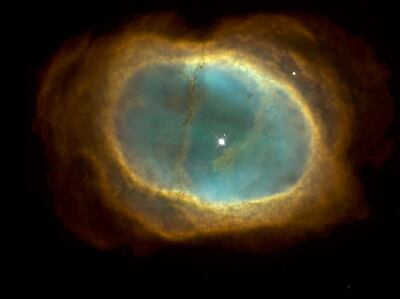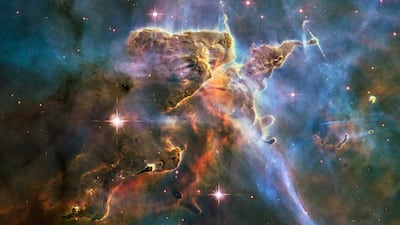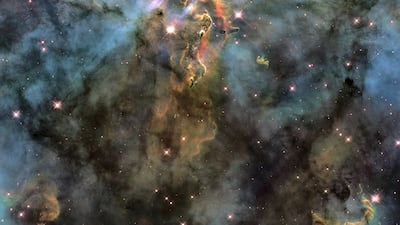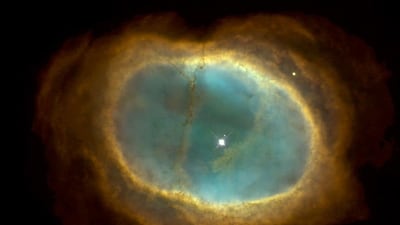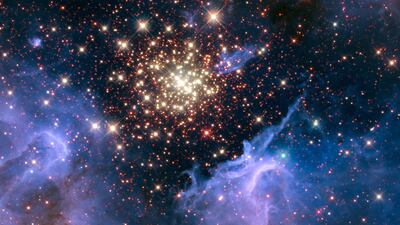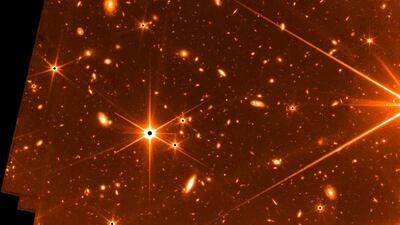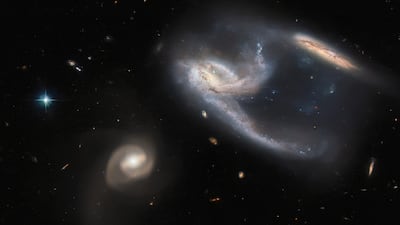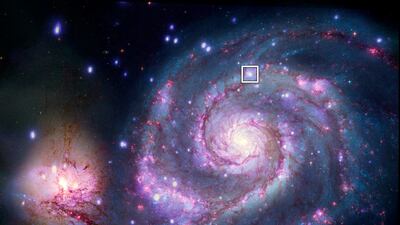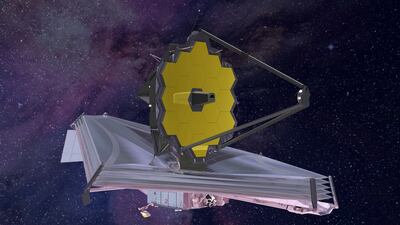One of the first full-colour images taken by the James Webb Space Telescope was released by US President Joe Biden on Monday in a step towards uncovering the universe's deepest secrets.
The unveiling took place during a live-streamed event, during which Nasa published a stunning, high-resolution image of the ancient universe brimming with a dizzying kaleidoscope of galaxies that were previously invisible to humankind.
The image showed “the oldest documented light in the history of the universe from over 13 billion — let me say that again — 13 billion years ago. It’s hard to fathom,” Mr Biden said during the unveiling.
The remaining images are set to be released by Nasa on Tuesday.
The $10 billion James Webb Space Telescope is the most powerful observatory ever sent into space. Equipped with a 6.5-metre, gold-plated beryllium mirror, the telescope should be able to look into the furthest corners of the universe and snap images of light from galaxies that formed a little after the Big Bang.
Because of the telescope's infrared capabilities, the universe is “giving up secrets that had been there for many, many decades, centuries, millennia,” Thomasi Zurbuchen, Nasa's science mission chief, said in a briefing.
Here are the images Nasa is planning to release:
SMACS 0723
The first image released is of the “deep field” — a long-lasting observation meant to reveal faint objects from the universe.
Nasa said the James Webb Telescope captured the image by pointing its main imager towards galaxy clusters called SMACS 0723, which bend the light of objects far behind them towards the observer, an effect called “gravitational lensing”. Part of the image will include light from not too long after the Big Bang.
Webb's infrared capabilities allow it to peel time further back than any other telescope before it, to roughly 13.8 billion years ago.
Nasa chief Bill Nelson said last month that this would be “deepest image of our Universe that has ever been taken.”
Carina Nebula
Also included in the first wave of images is the Carina Nebula, a massive cloud of dust and gas about 7,600 light years away. The nebula is best known for its “Mystic Mountain”, a three-light-year-tall pillar of gas previously captured by the Hubble Space Telescope.
Southern Ring Nebula
The Southern Ring Nebula, nearly half a light year in diameter, is 2,000 light years away from Earth.
This “Eight Burst” nebula, consisting of an expanding cloud of gas, surrounds a dying star.
WASP-96 b
Webb also conducted a spectroscopy — a study of the absorption and emission of light to reveal other information — on a distant gas giant called WASP-96 b, which was discovered in 2014.
About half the mass of Jupiter and 1,500 light years from earth, the gas giant travels around its star in 3.4 days.
Stephan's Quintet
This galaxy group situated in the constellation Pegasus is located 290 million light years away from Earth. It was the first compact galaxy group ever discovered.
Four of the five quintet's galaxies are “locked in a cosmic dance of repeated close encounters”, Nasa said.
Agencies contributed to this report
In numbers: China in Dubai
The number of Chinese people living in Dubai: An estimated 200,000
Number of Chinese people in International City: Almost 50,000
Daily visitors to Dragon Mart in 2018/19: 120,000
Daily visitors to Dragon Mart in 2010: 20,000
Percentage increase in visitors in eight years: 500 per cent
Federer's 11 Wimbledon finals
2003 Beat Mark Philippoussis
2004 Beat Andy Roddick
2005 Beat Andy Roddick
2006 Beat Rafael Nadal
2007 Beat Rafael Nadal
2008 Lost to Rafael Nadal
2009 Beat Andy Roddick
2012 Beat Andy Murray
2014 Lost to Novak Djokovic
2015 Lost to Novak Djokovic
2017 Beat Marin Cilic
More on Quran memorisation:
MATCH INFO
Champions League quarter-final, first leg
Ajax v Juventus, Wednesday, 11pm (UAE)
Match on BeIN Sports
White hydrogen: Naturally occurring hydrogen
Chromite: Hard, metallic mineral containing iron oxide and chromium oxide
Ultramafic rocks: Dark-coloured rocks rich in magnesium or iron with very low silica content
Ophiolite: A section of the earth’s crust, which is oceanic in nature that has since been uplifted and exposed on land
Olivine: A commonly occurring magnesium iron silicate mineral that derives its name for its olive-green yellow-green colour
Groom and Two Brides
Director: Elie Semaan
Starring: Abdullah Boushehri, Laila Abdallah, Lulwa Almulla
Rating: 3/5
The nine articles of the 50-Year Charter
1. Dubai silk road
2. A geo-economic map for Dubai
3. First virtual commercial city
4. A central education file for every citizen
5. A doctor to every citizen
6. Free economic and creative zones in universities
7. Self-sufficiency in Dubai homes
8. Co-operative companies in various sectors
9: Annual growth in philanthropy
The specs
Engine: 2.0-litre 4-cyl, 48V hybrid
Transmission: eight-speed automatic
Power: 325bhp
Torque: 450Nm
Price: Dh359,000
On sale: now
Company profile
Company: Rent Your Wardrobe
Date started: May 2021
Founder: Mamta Arora
Based: Dubai
Sector: Clothes rental subscription
Stage: Bootstrapped, self-funded
WHAT IS A BLACK HOLE?
1. Black holes are objects whose gravity is so strong not even light can escape their pull
2. They can be created when massive stars collapse under their own weight
3. Large black holes can also be formed when smaller ones collide and merge
4. The biggest black holes lurk at the centre of many galaxies, including our own
5. Astronomers believe that when the universe was very young, black holes affected how galaxies formed
UAE currency: the story behind the money in your pockets
Brief scores:
Kashima Antlers 0
River Plate 4
Zuculini 24', Martinez 73', 90 2', Borre 89' (pen)
COMPANY%20PROFILE
%3Cp%3E%3Cstrong%3EName%3A%20%3C%2Fstrong%3ESmartCrowd%0D%3Cbr%3E%3Cstrong%3EStarted%3A%20%3C%2Fstrong%3E2018%0D%3Cbr%3E%3Cstrong%3EFounder%3A%20%3C%2Fstrong%3ESiddiq%20Farid%20and%20Musfique%20Ahmed%0D%3Cbr%3E%3Cstrong%3EBased%3A%20%3C%2Fstrong%3EDubai%0D%3Cbr%3E%3Cstrong%3ESector%3A%20%3C%2Fstrong%3EFinTech%20%2F%20PropTech%0D%3Cbr%3E%3Cstrong%3EInitial%20investment%3A%20%3C%2Fstrong%3E%24650%2C000%0D%3Cbr%3E%3Cstrong%3ECurrent%20number%20of%20staff%3A%3C%2Fstrong%3E%2035%0D%3Cbr%3E%3Cstrong%3EInvestment%20stage%3A%20%3C%2Fstrong%3ESeries%20A%0D%3Cbr%3E%3Cstrong%3EInvestors%3A%20%3C%2Fstrong%3EVarious%20institutional%20investors%20and%20notable%20angel%20investors%20(500%20MENA%2C%20Shurooq%2C%20Mada%2C%20Seedstar%2C%20Tricap)%3C%2Fp%3E%0A
Iftar programme at the Sheikh Mohammed Centre for Cultural Understanding
Established in 1998, the Sheikh Mohammed Centre for Cultural Understanding was created with a vision to teach residents about the traditions and customs of the UAE. Its motto is ‘open doors, open minds’. All year-round, visitors can sign up for a traditional Emirati breakfast, lunch or dinner meal, as well as a range of walking tours, including ones to sites such as the Jumeirah Mosque or Al Fahidi Historical Neighbourhood.
Every year during Ramadan, an iftar programme is rolled out. This allows guests to break their fast with the centre’s presenters, visit a nearby mosque and observe their guides while they pray. These events last for about two hours and are open to the public, or can be booked for a private event.
Until the end of Ramadan, the iftar events take place from 7pm until 9pm, from Saturday to Thursday. Advanced booking is required.
For more details, email openminds@cultures.ae or visit www.cultures.ae
The%20Boy%20and%20the%20Heron
%3Cp%3E%3Cstrong%3EDirector%3A%C2%A0%3C%2Fstrong%3EHayao%20Miyazaki%3C%2Fp%3E%0A%3Cp%3E%3Cstrong%3EStarring%3A%3C%2Fstrong%3E%C2%A0Soma%20Santoki%2C%20Masaki%20Suda%2C%20Ko%20Shibasaki%3C%2Fp%3E%0A%3Cp%3E%3Cstrong%3ERating%3A%20%3C%2Fstrong%3E5%2F5%3C%2Fp%3E%0A
'Operation Mincemeat'
Director: John Madden
Cast: Colin Firth, Matthew Macfayden, Kelly Macdonald and Penelope Wilton
Rating: 4/5
THE BIO
Favourite holiday destination: Whenever I have any free time I always go back to see my family in Caltra, Galway, it’s the only place I can properly relax.
Favourite film: The Way, starring Martin Sheen. It’s about the Camino de Santiago walk from France to Spain.
Personal motto: If something’s meant for you it won’t pass you by.
Killing of Qassem Suleimani
HIJRA
Starring: Lamar Faden, Khairiah Nathmy, Nawaf Al-Dhufairy
Director: Shahad Ameen
Rating: 3/5
Dhadak 2
Director: Shazia Iqbal
Starring: Siddhant Chaturvedi, Triptii Dimri
Rating: 1/5
Specs
Engine: Duel electric motors
Power: 659hp
Torque: 1075Nm
On sale: Available for pre-order now
Price: On request
Specs
Engine: Electric motor generating 54.2kWh (Cooper SE and Aceman SE), 64.6kW (Countryman All4 SE)
Power: 218hp (Cooper and Aceman), 313hp (Countryman)
Torque: 330Nm (Cooper and Aceman), 494Nm (Countryman)
On sale: Now
Price: From Dh158,000 (Cooper), Dh168,000 (Aceman), Dh190,000 (Countryman)
A timeline of the Historical Dictionary of the Arabic Language
- 2018: Formal work begins
- November 2021: First 17 volumes launched
- November 2022: Additional 19 volumes released
- October 2023: Another 31 volumes released
- November 2024: All 127 volumes completed
SPECS
%3Cp%3EEngine%3A%20Supercharged%203.5-litre%20V6%0D%3Cbr%3EPower%3A%20400hp%0D%3Cbr%3ETorque%3A%20430Nm%0D%3Cbr%3EOn%20sale%3A%20Now%0D%3Cbr%3EPrice%3A%20From%20Dh450%2C000%0D%3Cbr%3E%3C%2Fp%3E%0A
THE TWIN BIO
Their favourite city: Dubai
Their favourite food: Khaleeji
Their favourite past-time : walking on the beach
Their favorite quote: ‘we rise by lifting others’ by Robert Ingersoll
Indoor cricket World Cup:
Insportz, Dubai, September 16-23
UAE fixtures:
Men
Saturday, September 16 – 1.45pm, v New Zealand
Sunday, September 17 – 10.30am, v Australia; 3.45pm, v South Africa
Monday, September 18 – 2pm, v England; 7.15pm, v India
Tuesday, September 19 – 12.15pm, v Singapore; 5.30pm, v Sri Lanka
Thursday, September 21 – 2pm v Malaysia
Friday, September 22 – 3.30pm, semi-final
Saturday, September 23 – 3pm, grand final
Women
Saturday, September 16 – 5.15pm, v Australia
Sunday, September 17 – 2pm, v South Africa; 7.15pm, v New Zealand
Monday, September 18 – 5.30pm, v England
Tuesday, September 19 – 10.30am, v New Zealand; 3.45pm, v South Africa
Thursday, September 21 – 12.15pm, v Australia
Friday, September 22 – 1.30pm, semi-final
Saturday, September 23 – 1pm, grand final
Wicked: For Good
Director: Jon M Chu
Starring: Ariana Grande, Cynthia Erivo, Jonathan Bailey, Jeff Goldblum, Michelle Yeoh, Ethan Slater
Rating: 4/5
The years Ramadan fell in May
First-round leaderbaord
-5 C Conners (Can)
-3 B Koepka (US), K Bradley (US), V Hovland (Nor), A Wise (US), S Horsfield (Eng), C Davis (Aus);
-2 C Morikawa (US), M Laird (Sco), C Tringale (US)
Selected others: -1 P Casey (Eng), R Fowler (US), T Hatton (Eng)
Level B DeChambeau (US), J Rose (Eng)
1 L Westwood (Eng), J Spieth (US)
3 R McIlroy (NI)
4 D Johnson (US)
More from Neighbourhood Watch:
Company name: Farmin
Date started: March 2019
Founder: Dr Ali Al Hammadi
Based: Abu Dhabi
Sector: AgriTech
Initial investment: None to date
Partners/Incubators: UAE Space Agency/Krypto Labs
The biog
Name: Sari Al Zubaidi
Occupation: co-founder of Cafe di Rosati
Age: 42
Marital status: single
Favourite drink: drip coffee V60
Favourite destination: Bali, Indonesia
Favourite book: 100 Years of Solitude
WTL%20SCHEDULE
%3Cp%3EDECEMBER%2019%20(6pm)%0D%3Cbr%3EKites%20v%20Eagles%0D%3Cbr%3EAliassime%20v%20Kyrgios%0D%3Cbr%3ESwiatek%20v%20Garcia%0D%3Cbr%3EEntertainment%3A%20Tiesto%3C%2Fp%3E%0A%3Cp%3EDECEMBER%2020%20(6pm)%0D%3Cbr%3EFalcons%20v%20Hawks%0D%3Cbr%3EDjokovic%20v%20Zverev%0D%3Cbr%3ESabalenka%20v%20Rybakina%0D%3Cbr%3EEntertainment%3A%20Wizkid%0D%3Cbr%3E%0D%3Cbr%3EDECEMBER%2021%20(6pm)%0D%3Cbr%3EFalcons%20v%20Eagles%0D%3Cbr%3EDjokovic%20v%20Kyrgios%0D%3Cbr%3EBadosa%20v%20Garcia%0D%3Cbr%3EEntertainment%3A%20Ne-Yo%0D%3Cbr%3E%0D%3Cbr%3EDECEMBER%2022%20(6pm)%0D%3Cbr%3EHawks%20v%20Kites%0D%3Cbr%3EThiem%20v%20Aliassime%0D%3Cbr%3EKontaveit%20v%20Swiatek%0D%3Cbr%3EEntertainment%3A%20deadmau5%0D%3Cbr%3E%0D%3Cbr%3EDECEMBER%2023%20(2pm)%0D%3Cbr%3EEagles%20v%20Hawks%0D%3Cbr%3EKyrgios%20v%20Zverev%0D%3Cbr%3EGarcia%20v%20Rybakina%0D%3Cbr%3EEntertainment%3A%20Mohammed%20Ramadan%0D%3Cbr%3E%0D%3Cbr%3EDECEMBER%2023%20(6pm)%0D%3Cbr%3EFalcons%20v%20Kites%0D%3Cbr%3EDjokovic%20v%20Aliassime%0D%3Cbr%3ESabalenka%20v%20Swiatek%0D%3Cbr%3EEntertainment%3A%20Mohammed%20Ramadan%0D%3Cbr%3E%0D%3Cbr%3EDECEMBER%2024%20(6pm)%0D%3Cbr%3EFinals%0D%3Cbr%3EEntertainment%3A%20Armin%20Van%20Buuren%0D%3Cbr%3E%0D%3C%2Fp%3E%0A

